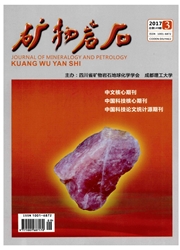

 中文摘要:
中文摘要:
采用摇瓶浸出、分批搅拌浸出与连续浸出3种方式,研究3株"硅酸盐"细菌(胶质芽孢杆菌,Bacillus mucilaginosus,BMN;环状芽孢杆菌,Bacillus circulans,BCM;根瘤菌Rhizobium spp.HJ07)对铝土矿中硅的单一浸出和混合浸出效果,并对浸矿过程中混合菌群落结构的动态变化进行分析。研究结果表明:混合菌对铝土矿中硅的浸出率高于单一菌对铝土矿中硅的浸出率;连续浸出方式的脱硅率最高,其次为搅拌浸出,摇瓶浸出的脱硅率最低,浸出15 d后,3种混合菌对铝土矿中Si O2的浸出率分别为71.3%,49.5%和39.2%,铝土矿的m(Al)/m(Si)从5.17分别提高到13.51,10.2和8.76;在铝土矿混合菌浸出前期,没有明显的优势菌种,而到中后期,Bacillus mucilaginosus的比例则会上升,并最后取代Bacillus circulans和Rhizobium spp.成为优势菌种。
 英文摘要:
英文摘要:
Single bioleaching (Bacillus mucilaginosus BMN or Bacillus circulans BCM or Rhizobium spp. HJ07) and a cooperative bioleaching (Bacillus mucilaginosus BM'N and Bacillus circulans BCM and Rhizobium spp. H J07) of bauxite were investigated by using three bioleaching technologies of flask leaching, batch leaching and continuous leaching. The change of bacterial community structure during bioleaching process was analysed by bacterial identification of representative phenotypic and physiological and biochemical characteristics. The results show that the SiO2 extraction from bauxite by mixed culture is higher than that by single culture. The SlOE leaching rate in the continuous bioleaching process is the highest, and the lowest in the flask bioleaching process, in comparison with the three bioleaching technologies of continuous leaching, batch leaching and flask leaching. After a 15 d cooperative bioleaching, the SiO2 leaching rates are 71.3%, 49.5% and 39.2%, and the mass ratio of A12O3 to SiO2 in bauxite is increased from 5.17 to 13.51, 10.20 and 8.76, respectively. There is no obvious dominant culture in bacterial community at the early bioleaching stage, in comparison with the ratio change of three tested silicate bacteria, whereas Bacillus mucilaginosus thrives at later stage and tunas into the dominant culture.
 同期刊论文项目
同期刊论文项目
 同项目期刊论文
同项目期刊论文
 期刊信息
期刊信息
